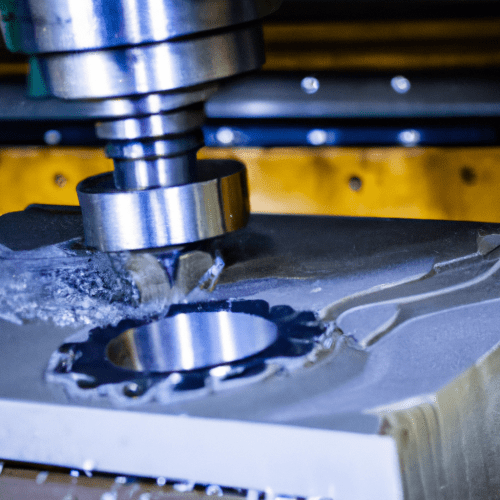CNC metrology is a field of engineering and technology that focuses on the accuracy, precision, precision, and accuracy of digital measurements. It utilizes CNC machines and related tools and technologies to produce precise equipment and parts. Its purpose is to ensure that the parts, equipment, and machines used for manufacturing processes and operations are designed, built, and operated accurately.
This field of engineering involves the use of design software and other sophisticated CNC tools to create extremely precise and accurate parts. Metrology typically involves the application of calculations and principles of physics to determine the actual size and shape of an object. It is the application of scientific methods to precision manufacturing. CNC metrology typically involves generating, measuring, and analyzing data to assess the manufacturing processes to ensure accuracy and quality control requirements are met.
CNC metrology is an important aspect of manufacturing since it helps companies to develop high-quality products that meet customer expectations and minimize risks of product failure or recalls. The quality of parts and components must be consistent and meet all applicable standards to ensure reliability, longevity, and safety of the products being manufactured. CNC metrology techniques are also essential to detecting defects, product flaws, and other irregularities, making them indispensable for quality assurance, product traceability and process optimization.
What is a metrology tool?
A metrology tool is an instrument or device used in the field of metrology to measure properties of physical objects, such as length, weight, dimension, shape, angles and surface area. It is often used to measure dimensions on manufactured parts and components to ensure that they meet specifications and engineering drawings. Metrology tools can be used in a variety of industries, such as automotive, aerospace, medical, industrial and engineering.
These tools can include calipers, micrometers, gages and protractors, to name a few. Calipers, for example, are used to measure the thickness or diameter of an object, whereas micrometers are used for measuring small distances with a high degree of accuracy. Gages are used to verify that parts fit into a certain location or dimension, while protractors measure angles. Additionally, many metrology tools also have computerized or automated components, such as Coordinate Measuring Machines (CMMs) that use lasers and cameras to collect a variety of measurements and then feed them into a computer program for analysis.
Metrology tools are essential for ensuring that engineers, manufacturers and suppliers create safe, reliable and durable products. They also help to ensure compliance with internal and industry standards and regulations, which helps to improve customer satisfaction. Metrology tools can also help manufacturers reduce costs and enhance throughput, as they enable faster and more accurate production of parts, components and assemblies.
How are CNC machines measured?
CNC machines are typically measured by a range of metrics, including accuracy, speed, repeatability, and rigidity. Accuracy, or the ability of a CNC machine to execute a given task with minimal deviation from the desired result, is measured by comparing the actual output of the machine with a predetermined design. Speed, or the amount of time it takes for the machine to complete the job, is measured in either the linear speed (distance per minute) or the surface speed (area per minute).
Repeatability, or the machine’s ability to repeat a particular job with accurate, identical results, is typically measured by repeating the same job multiple times. Finally, rigidity, or the machine’s resistance to external forces or vibration, is commonly measured through the use of a strain gauge. For other, more specific metrics, such as precision or torque, it is best to consult the manufacturer of the machine in question.
Is CMM a metrology?
Yes, CMM is a metrology. Coordinate measuring machines (CMMs) are measuring systems that use probe styli connected to a computer to precisely take measurements of a manufactured part and compare it to the design specifications. CMMs are one of several types of metrology or measurement systems used in manufacturing and industrial production. Metrology is the science and technology of measurement, and involves a wide variety of methods to measure length, angle, or form. CMMs are particularly valuable, as they can measure all three of these aspects of a manufactured part in three dimensions. They are used in industries including aerospace and automotive, to ensure parts are manufactured according to very precise specifications.
What is CMM and VMM?
CMM (Capability Maturity Model) is a software development model developed by the Software Engineering Institute (SEI) at Carnegie Mellon University to measure the organizational maturity of a software development team and identify areas for improvement. CMM establishes five maturity levels, each corresponding to a distinct set of goals and tasks that must be achieved by a software development organization in order to reach that level: Initial, Repeatable, Defined, Managed, and Optimizing. Each level builds on the previous level and helps to fill in the details of a software development process.
VMM (Value Maturity Model) is an approach used to measure the degree of value realization within an organization. VMM focuses on determining the effectiveness of organizational agility and responsiveness to changing customer needs and markets. It also evaluates the ability of an organization to increase the value of their products and services over a period of time. VMM is comprised of six key areas, including Lean Thinking, Operational Excellence, Enterprise Agility, Innovative Delivery, Performance Management, and Governance. Each of these areas assesses the organization’s ability to realize value from their investments.
